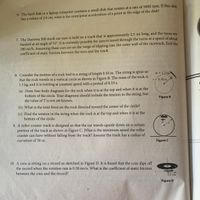Question
thumb_up100%
Can you please answer number 8. Tysm❤️

Transcribed Image Text:6. The hard disk in a laptop computer contains a small disk that rotates at a rate of 5000 rpm. If this disk
has a radius of 2.0 cm, what is the centripetal acceleration of a point at the edge of the disk?
7. The Daytona 500 stock car race is held on a track that is approximately 2.5 mi long, and the turns are
banked at an angle of 31°. It is currently possible for cars to travel through the turns at a speed of about
180 mi/h. Assuming these cars are on the verge of slipping into the outer wall of the racetrack, find the
coefficient of static friction between the tires and the track.
8. Consider the motion of a rock tied to a string of length 0.50 m. The string is spun so
that the rock travels in a vertical circle as shown in Figure B. The mass of the rock is
1.5 kg, and it is twirling at constant speed with a period of 0.33 s.
1.5 kg
r = 0.50 m
(a) Draw free-body diagrams for the rock when it is at the top and when it is at the
bottom of the circle. Your diagrams should include the tension in the string, but
the value of T is not yet known.
Figure B
(b) What is the total force on the rock directed toward the center of the circle?
(c) Find the tension in the string when the rock is at the top and when it is at the
bottom of the circle.
9. A roller-coaster track is designed so that the car travels upside down on a certain
portion of the track as shown in Figure C. What is the minimum speed the roller
coaster can have without falling from the track? Assume the track has a radius of
curvature of 30 m.
Figure C
10. A coin is sitting on a record as sketched in Figure D. It is found that the coin slips off
the record when the rotation rate is 0.30 rev/s. What is the coefficient of static friction
between the coin and the record?
115 cm
Figure D
Expert Solution
This question has been solved!
Explore an expertly crafted, step-by-step solution for a thorough understanding of key concepts.
This is a popular solution
Trending nowThis is a popular solution!
Step by stepSolved in 4 steps with 1 images

Knowledge Booster
Similar questions
arrow_back_ios
arrow_forward_ios